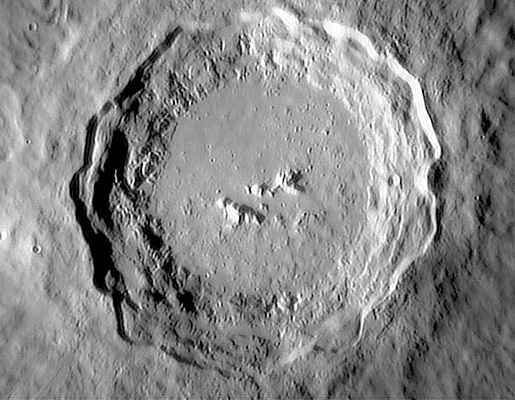Copernicus is the most important crater on the Moon. How can I call out any one as "most important," you ask? Let me modify the first sentence and you will probably agree: Copernicus is the most important crater on the Moon because of what it has taught us. Here are three lessons. (1) 93 km wide Copernicus is the prototype of a complex impact crater. For lunar craters with diameters larger than about 15 km there are three consistent characteristics: inner walls with slumps or terraces, large relatively flat floors, and central peaks. (2) Eugene Shoemaker used Copernicus as the type example in his analysis of the physics of impact crater formation, explaining the features above, and secondary craters and rays. (3) Copernicus is more complicated than we usually admit. I discovered that, compared to other fresh complex craters, Copernicus is too shallow by 0.7 km, and its peaks are too low by 1 km. Thus, Copernicus is filled by 0.7 to 1.0 km of unknown material. Its not likely to be impact melt (which should only be 0.25 km thick), and the other option - lava flows - is generally not liked because of the implication that the Moon was still hot only 1 billion years ago. So as you admire this exceptional image from Bruno Daversin using the Ludiver 24" telescope consider what the smooth material on the floor could be - lava, impact melt or just the random deviations from averages.
Technical Details:
Image obtained 2003 october 18th, 04h33 UT with Ludiver Observatory (Normandy, France) 600 mm (24") F/D=16
cassegrain telescope + infrared filter + TouCam Pro in B&W mode. Seeing: 7/10 Pickering. Processed with IRIS
freeware: 400 frames registred, addition, vancittert filter applied. South is up.
Related Links:
Ludiver Observatory and Planetarium Moon Atlas
Clementine Multispectral view and floor evidence
Lunar Orbiter V view
|
Yanvar' Fevral' Mart Aprel' Mai Iyun' Iyul' Avgust Sentyabr' Oktyabr' Noyabr' Dekabr' |
|
Publikacii s klyuchevymi slovami:
Moon - Luna - Lunar Photo of the Day - LPOD
Publikacii so slovami: Moon - Luna - Lunar Photo of the Day - LPOD | |
Sm. takzhe:
Vse publikacii na tu zhe temu >> | |
